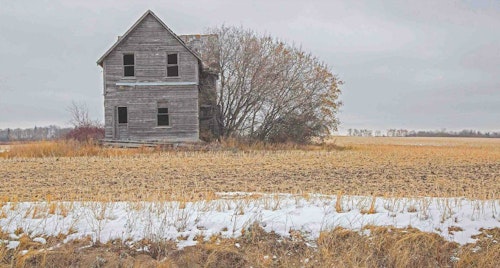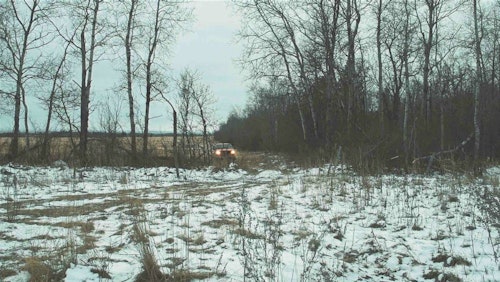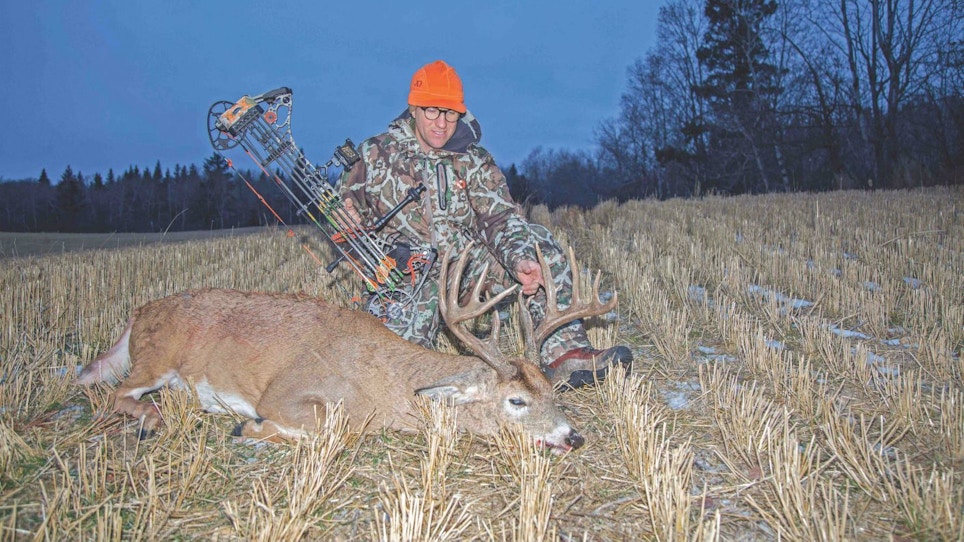The hum of asphalt on all-terrain tires was the background of our conversation as we headed north out of Arkansas on October 27. “Can you even get to Manitoba from here?” I chided with my father-in-law riding in the passenger seat of my Silverado. We were headed to western Manitoba where the mighty boreal forest merges with the prairie, like a green ocean meeting the land. It’s big whitetail country, probably the best either of us had hunted. Heavy, dark-horned racks looted our thoughts and conversations as the 22-hour roadtrip rolled on.
I’d been shooting my traditional bow the entire 2017 season and didn’t even have a compound set up. I’d decided to carry the Mathews HALON 6 that had hung in my home office since summer. I knew we’d be hunting some open crop ground and figured the extra range a compound provides might be necessary.
In the 1990s and through the early 2000s, Canada was all the rage when it came to big whitetails. Milo Hanson’s world record typical from Saskatchewan still stands as No. 1, and it was killed 60 miles from where we’d be hunting in Manitoba. In the last decade, the attention of whitetail hunters has shifted to the Midwestern United States for many reasons. However, it’s a great time for serious whitetail hunters to look back to Canada. I thought a guided hunt would cost $6,500 to $7,500, however, that just isn’t the case with each outfit north of our border. Our hunt with Tom Ainsworth of Grandview Outfitters was less than many Midwestern leases, and less than half the cost of my assumptions. This would be my first guided whitetail hunt, and it was very different from the stereotypical hype. It seemed that it was going to be a lot like hunting a good friend’s property.

Upon arriving in southwestern Manitoba, we were greeted with Iowa-like terrain, or at least to my eyes. Large agricultural fields of wheat, oats and canola created a patchwork quilt between large blocks of timber. Tom’s 3,000-plus acres of private land borders a massive tract of public land, or what Canadians call “Crown Land.” Its proximity to the big woods provides a high game count. It’s a very unique whitetail hunt because the property has elk, whitetails and black bears. I expected deer numbers to be low, but I was pleased when we saw lots of deer while driving the property before the hunt. We even saw a bear on the first evening.
The key to my success would be hunting over large alfalfa and wheat fields. As a bowhunter, it’s intimidating to hunt wide-open country, but we’d learn that the deer were very visible and patternable. Surprisingly, many of the bucks were still grouped together, and by late October, were showing much less rut activity than Midwestern deer during this time period.

On the hunt’s second morning, Tom saw a big buck feeding with a group of does on the edge of a field near an open gate. Having decades of experience observing deer on the farm, Tom knew just what to do. When he picked me up he said, “I’ve got a new place I’m going to put you this afternoon. We’ll need to put up a stand.”
After driving a half-mile through a cut wheat field, we came to an open gate at the corner of the field. “This is where I saw the buck this morning,” Tom said. I trusted Tom because of his track record on big whitetails, but the spot had me guessing.
Why would a big buck show up right here? I thought. After driving the truck right through the gate, we placed a ladder stand in a poplar tree that wasn’t much more than 14 inches at the base. Oh, and it didn’t have a leaf on it, but I figured the thick spruce behind the poplar would provide the needed background cover. The wind was right, and though I wasn’t confident in the spot, I was about to get an education on big northern bucks. Within 2 hours I was standing over a 150-inch-plus Canadian stud. Here are four things I learned:
1. Don’t Overlook the Obvious
As modern whitetails hunters, we’re often so calculated and sneaky we can overlook the obvious because it doesn’t fit into our ideology of how a big buck should be killed. We get a charge out of applying the latest techniques and can strategize to a fault. Sometimes it’s as simple as “I saw a buck in that field this morning, so I’m going to hunt there this evening.” Sounds amateur, right? But it worked for me in Canada.
Nearly 20 years ago, I started hunting a cattle farm in Arkansas. From day one the non-bowhunting landowner told me what the deer were doing, where they were feeding and where he thought I should hunt. I didn’t trust him. I assumed he noticed the obvious, but was missing the true indicators that would help me kill a big buck. Today, I call the landowner almost every time I hunt the property and ask him what he’s been noticing. He knows whitetails through simple observation, even though he doesn’t read the latest how-to-hunt deer articles or watch outdoor television.
The more I bowhunt, the more I pay attention to the obvious and learn from others in the area I’m hunting. When more than two people say the same thing, it’s often a trend. Early on, I was convinced that killing a big buck was the result of a series of calculated decisions based upon interpretation of details that only an expert could decipher. I’m not so sure anymore. I’m not suggesting we throw our brains and knowledge of whitetails out the window. I am suggesting that it might not be as complicated as the modern trends suggest. I think it’s more a factor of getting the wind right, hunting regions that hold big bucks, hunting long hours and being able to capitalize when you’re presented with an opportunity.

2. Hunt It While It’s Hot
Everything in life has a time stamp. The window of opportunity is limited on almost everything: business opportunities, physical health and having children to name a few. Whitetail hunting is no different. Successful hunters know when to strike just like a lion knows just when to burst from cover to attack a herd of wildebeest.
When I was 17 years old, I was baiting wild hogs for the first time. I didn’t have trail cameras, but my visit to the site told me that the hogs had found it. I thought, When should I hunt those hogs? My inexperienced mind was bouncing around the options, when a voice screamed in my head, You’ve got to hunt NOW! The next day, I was hunting hogs and killed one on the first sit. This moment activated a voice in my mind that I’ve learned to trust. It may sound elementary, but knowing when to strike is a key for predators.
These Canadian deer have almost unlimited access to food. With all the options available to them, the deer may be in one field for a few days and then shift a quarter-mile to another food source. The best time to hunt the buck you saw “this morning” is often “this evening.” Strike while the iron is hot to kill a big buck this year.

3. Hunting Feeding Pattern Pre-Rut Bucks
This was my first time to hunt deer this far north. In Arkansas, late October is a pre-rut frenzy and offers some of our best hunting. I assumed we’d see that same thing in the North. The mild weather of the South creates a wide range of optimal fawning dates making the time for conception (the rut) more spread out. Fawn birth in the North is much more precise. They must be born in a short window for them to miss the cold temperatures of the winter they’re exiting, and have enough time to grow before the winter they’ll be entering. What does this mean for hunters? The rut and pre-rut are extremely compact.
My father-in-law and I hunted from October 30 through November 3 and saw several groups of bucks still in bachelor groups. The temperatures were optimal for deer movement, ranging from 20 to 40 degrees Fahrenheit over the course of the hunt. In my opinion, the small amount of rut activity wasn’t weather induced. We were hunting these bucks almost entirely on feeding patterns, and it worked to our advantage.
The bucks we observed were extremely patternable. If the rut had been in full swing, it could have been the classic hit-and-miss hunt. However, we knew exactly where the deer were going to be. You’ve got to hunt smart because if you bump them off of food, the pattern gets blown. You can’t afford this mistake on a short hunt. The best hunts are going to be your first few sits, so capitalize on every opportunity you get. My father-in-law was muzzleloader hunting and had an opportunity at a 150-inch deer on the second day, but the gun misfired. The bachelor group boogered and we never got back on them the rest of the week.

4. Southerners Guide to Judging Canadian Bucks
Tom set our expectations realistically about the size of deer we’d be hunting. “You’ll be hunting 140- to 160-inch deer. We’ve got some bigger than that, but they’re hard to come by.” I appreciated his honesty. However, what I couldn’t fully prepare for was field-judging Canadian bucks. I’m familiar with mature bucks weighing 165 to 185 pounds; a buck this size with a 140-inch rack looks like a giant. These big Canadian bucks are huge, however, and almost every one will tip the scales well over 225 pounds; some will soar over 250.
I’m an official Boone and Crockett scorer, so I’m familiar with whitetail scores and have become a student of field judging deer. After killing my buck, I would learn just how much I needed to calibrate my judgment, which was about 15 inches. When I first saw my buck on the hoof, I thought he was a 135-inch deer. However, as he got closer and I saw what a brute he was, I figured I was looking at a 150-inch deer, even though my eyes didn’t believe it. Even after I had the rack in hand, the huge body still fooled me. I still thought I was looking at a 140-inch deer. These mature Canadian deer have a lot of mass — it’s the most iconic feature of a big northern buck.
Here’s the take away: Don’t let a whitetail buck of a lifetime walk past you in Canada. He may be bigger than he looks!






